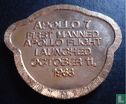

Enlarge image
USA Apollo VII (1st manned) Space Mission 1968


Catalogue information
LastDodo number
6613899
Area
Tokens / Medals
Title
USA Apollo VII (1st manned) Space Mission 1968
Publisher
Value
Country
Year
1968
Weight
Variety / overstrike
Obverse
VII : SCHIRRA - EISELE - CUNNINGHAM
Reverse
APOLLO 7, FIRST MANNED APOLLO FLIGHT, Launched October 11, 1963
Privy mark
Mint mark
Designer
Engraver
Dimensions / Diameter
34
Number
Details
Mass: 23 grams
Apollo 7 was the first mission in the United States' Apollo program to carry a crew into space. It was also the first U.S. spaceflight to carry astronauts since the flight of Gemini XII in November 1966. The AS-204 mission, also known as "Apollo 1", was intended to be the first manned flight of the Apollo program. It was scheduled to launch in February 1967, but a fire in the cabin during a January 1967 test killed the crew.
Manned flights were then suspended for 21 months, while the cause of the accident was investigated and improvements made to the spacecraft and safety procedures, and unmanned test flights of the Saturn V rocket and Apollo Lunar Module were made. Apollo 7 fulfilled Apollo 1's mission of testing the Apollo Command/Service Module (CSM) in low Earth orbit.
The Apollo 7 crew was commanded by Walter M. Schirra, with senior pilot- navigator Donn F. Eisele, and pilot-systems engineer R. Walter Cunningham.
Official crew titles were made consistent with those that would be used for the manned lunar landing missions: Eisele was Command Module Pilot and Cunningham was Lunar Module Pilot. Their mission was Apollo's 'C' mission, an 11-day Earth-orbital test flight to check out the redesigned Block II CSM with a crew on board. It was the first time a Saturn IB vehicle put a crew into space; Apollo 7 was the first 3-person American space mission, and the first to include a live TV broadcast from an American spacecraft. It was launched on October 11, 1968, from what was then known as Cape Kennedy Air Force Station, Florida. Despite tension between the crew and ground controllers, the mission was a complete technical success, giving NASA the confidence to send Apollo 8 into orbit around the Moon two months later. The flight would prove to be the final space flight for all of its three crew members — and the only one for both Cunningham and Eisele — when it splashed down in the Atlantic Ocean on October 22, 1968. It was also the only manned launch from Launch Complex 34, as well as the last launch from the complex.



